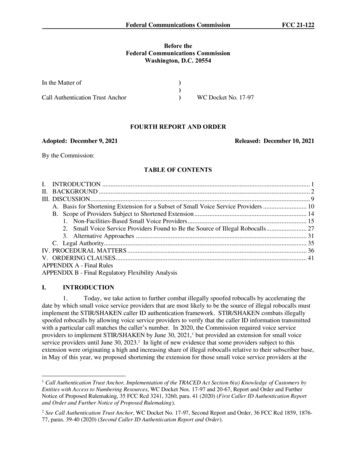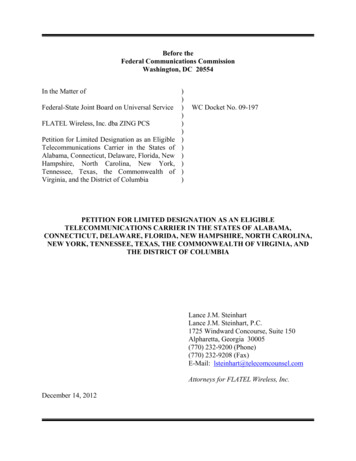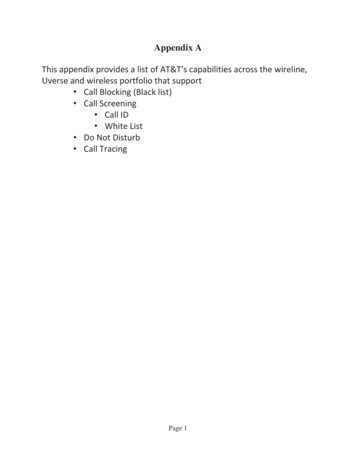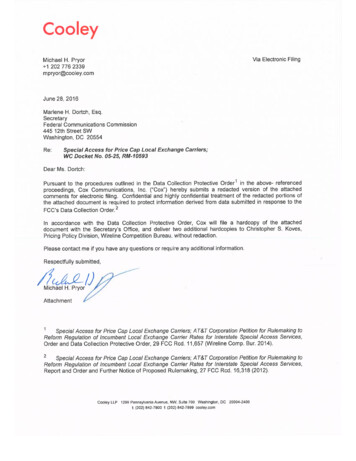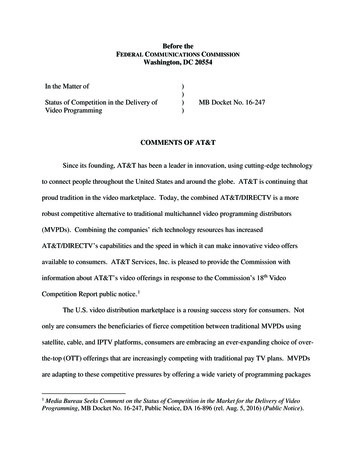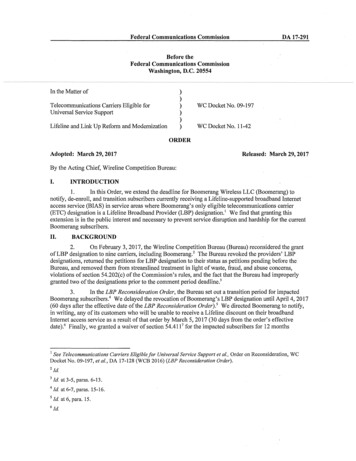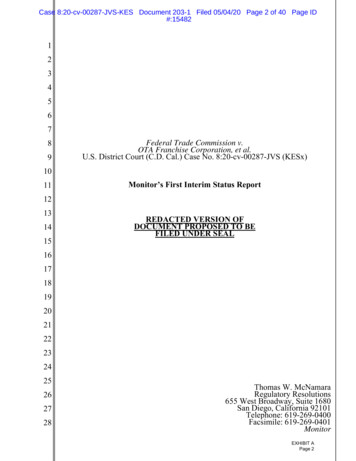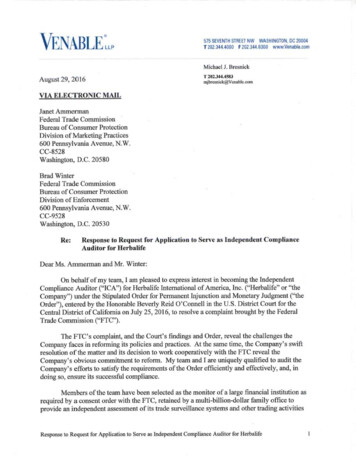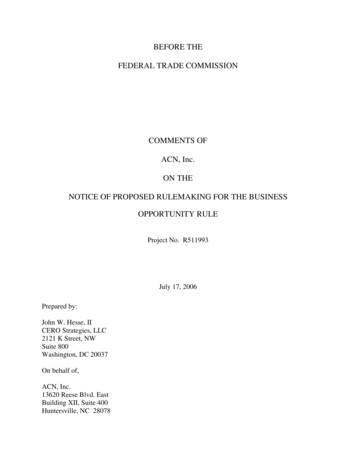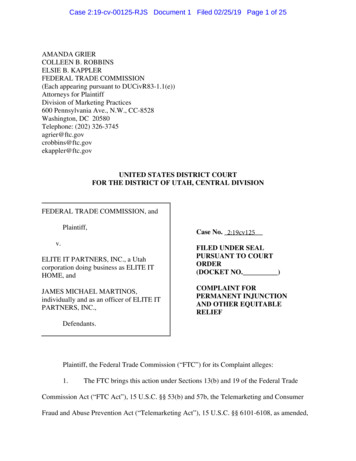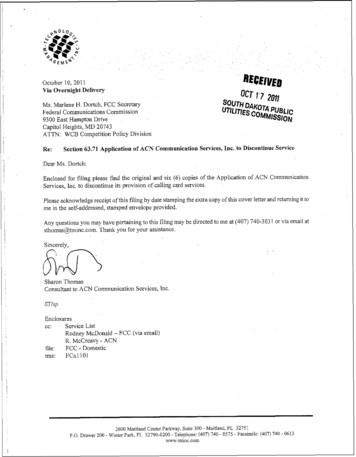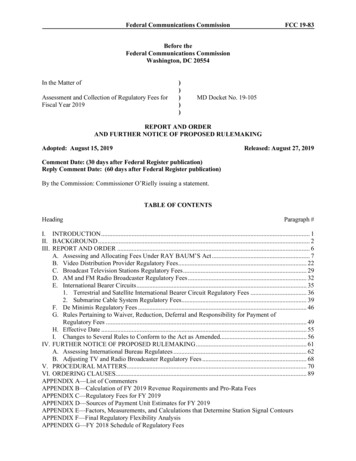
Transcription
Federal Communications CommissionFCC 19-83Before theFederal Communications CommissionWashington, DC 20554In the Matter ofAssessment and Collection of Regulatory Fees forFiscal Year 2019)))))MD Docket No. 19-105REPORT AND ORDERAND FURTHER NOTICE OF PROPOSED RULEMAKINGAdopted: August 15, 2019Released: August 27, 2019Comment Date: (30 days after Federal Register publication)Reply Comment Date: (60 days after Federal Register publication)By the Commission: Commissioner O’Rielly issuing a statement.TABLE OF CONTENTSHeadingParagraph #I. INTRODUCTION . 1II. BACKGROUND . 2III. REPORT AND ORDER . 6A. Assessing and Allocating Fees Under RAY BAUM’S Act . 7B. Video Distribution Provider Regulatory Fees . 22C. Broadcast Television Stations Regulatory Fees . 29D. AM and FM Radio Broadcaster Regulatory Fees . 32E. International Bearer Circuits . 351. Terrestrial and Satellite International Bearer Circuit Regulatory Fees . 362. Submarine Cable System Regulatory Fees. 39F. De Minimis Regulatory Fees . 46G. Rules Pertaining to Waiver, Reduction, Deferral and Responsibility for Payment ofRegulatory Fees . 49H. Effective Date . 55I. Changes to Several Rules to Conform to the Act as Amended. 56IV. FURTHER NOTICE OF PROPOSED RULEMAKING . 61A. Assessing International Bureau Regulatees . 62B. Adjusting TV and Radio Broadcaster Regulatory Fees . 68V. PROCEDURAL MATTERS . 70VI. ORDERING CLAUSES. 89APPENDIX A—List of CommentersAPPENDIX B—Calculation of FY 2019 Revenue Requirements and Pro-Rata FeesAPPENDIX C—Regulatory Fees for FY 2019APPENDIX D—Sources of Payment Unit Estimates for FY 2019APPENDIX E—Factors, Measurements, and Calculations that Determine Station Signal ContoursAPPENDIX F—Final Regulatory Flexibility AnalysisAPPENDIX G—FY 2018 Schedule of Regulatory Fees
Federal Communications CommissionFCC 19-83APPENDIX H—Rule ChangesAPPENDIX I—Initial Regulatory Flexibility AnalysisAPPENDIX J—FY 2019 Full Power Broadcast Television Regulatory Fees by Call SignI.INTRODUCTION1.Each year, the Commission must adopt a new schedule of regulatory fees for regulatorypayors, i.e., those entities required to fund the Commission’s activities. In this Report and Order, weadopt a schedule to collect the 339,000,000 in congressionally required regulatory fees for fiscal year(FY) 2019.1 These regulatory fees are due in September 2019. We also adopt several targetedamendments to our rules to conform with the text of the Communications Act of 1934, as amended by theRAY BAUM’S Act.2 And in the attached Further Notice of Proposed Rulemaking, we seek comment onseveral proposals to amend our schedule of regulatory fees for FY 2020.II.BACKGROUND2.The Commission is required by Congress to assess regulatory fees each year in anamount that can reasonably be expected to equal the amount of its appropriation.3 Regulatory feesrecover direct costs, such as salary and expenses; indirect costs, such as overhead functions; and supportcosts, such as rent, utilities, and equipment.4 Regulatory fees also cover the costs incurred in regulatingentities that are statutorily exempt from paying regulatory fees (e.g., governmental and nonprofit entities,amateur radio operators, and noncommercial radio and television stations)5 and entities whose regulatoryfees are waived.63.The Commission’s methodology for assessing regulatory fees must “reflect the full-timeequivalent number of employees within the bureaus and offices of the Commission, adjusted to take intoaccount factors that are reasonably related to the benefits provided to the payor of the fee by theCommission’s activities.”7 Since 2012, the Commission has assessed the allocation of full-timeequivalents (FTE)8 by first determining the number of FTEs in each “core” bureau that carries outlicensing activities (i.e., the Wireless Telecommunications Bureau, Media Bureau, Wireline Competition1Consolidated Appropriations Act, 2019, Pub. L. No. 116-6, Division D—Financial Services and GeneralGovernment Appropriations Act, 2019, Title V—Independent Agencies (2019) (FY 2019 Appropriation).2The Repack Airwaves Yielding Better Access for Users of Modern Services Act of 2018, or the RAY BAUM’SAct of 2018, amended sections 8 and 9 and added section 9A to the Communications Act, effective October 1, 2018.See Consolidated Appropriations Act, 2018, Pub. L. No. 115-141, 132 Stat. 1084, Division P – RAY BAUM’S Actof 2018, Title I, § 103 (2018); 47 U.S.C. §§ 159, 159A.347 U.S.C. § 159(a).4Assessment and Collection of Regulatory Fees for Fiscal Year 2004, Report and Order, 19 FCC Rcd 11662, 11666,para. 11 (2004) (FY 2004 Report and Order).547 U.S.C. § 159(e).647 CFR § 1.1166.747 U.S.C. § 159(d); see prior section 9(b) (fees “derived by determining the full-time equivalent number ofemployees performing the activities described in subsection (a) within the Private Radio Bureau, Mass MediaBureau, Common Carrier Bureau, and other offices of the Commission, adjusted to take into account factors that arereasonably related to the benefits provided to the payor of the fee by the Commission’s activities. . . “).8One FTE, a “Full Time Equivalent” or “Full Time Employee,” is a unit of measure equal to the work performedannually by a full time person (working a 40-hour workweek for a full year) assigned to the particular job, andsubject to agency personnel staffing limitations established by the U.S. Office of Management and Budget.2
Federal Communications CommissionFCC 19-83Bureau, and International Bureau) and then attributing all other FTEs to payor categories based on thesecore FTE allocations.94.As part of its annual regulatory fee rulemaking process, the Commission seeks commentto improve the regulatory fee methodology and has adopted significant regulatory fee reforms. Forexample, in 2013, the Commission updated FTE allocations to more accurately reflect the number ofFTEs working on regulation and oversight of regulatees in the payor categories.10 In 2014, theCommission adopted a new regulatory fee subcategory for toll free numbers within the InterstateTelecommunications Service Provider (ITSP) category.11 In 2015, the Commission adopted a regulatoryfee for Direct Broadcast Satellite (DBS), as a subcategory of the cable television and IPTV fee category,12and reallocated four additional International Bureau FTEs from direct to indirect.13 In 2016, theCommission adjusted regulatory fees for radio and television broadcasters, based on the type and class ofservice and on the population served.14 In 2017, the Commission reallocated as indirect 38 FTEs in theWireline Competition Bureau assigned to work on non-high cost programs of the Universal ServiceFund.15 The Commission also reallocated for regulatory fee purposes four FTEs assigned to work onnumbering issues from the Wireline Competition Bureau to the Wireless Telecommunications Bureau16and added non-common carrier terrestrial international bearer circuits (IBCs) as payors.17 In 2018, theCommission adopted new tiers for submarine cable regulatory fees,18 a new methodology for calculatingfull power broadcast television regulatory fees,19 and amended the rules regarding the collection ofdelinquent debt.205.In 2018, as part of the RAY BAUM’S Act, Congress revised the Commission’sregulatory fee authority by modifying section 9 and adding section 9A to the Communications Act.21 In9Procedures for Assessment and Collection of Regulatory Fees, Notice of Proposed Rulemaking, 27 FCC Rcd 8458,8460, para. 5 & n.5 (2012) (FY 2012 NPRM).10Assessment and Collection of Regulatory Fees for Fiscal Year 2013, Report and Order, 28 FCC Rcd 12351,12354-58, paras. 10-20 (2013) (FY 2013 Report and Order).11Assessment and Collection of Regulatory Fees for Fiscal Year 2014, Report and Order and Further Notice ofProposed Rulemaking, 29 FCC Rcd 10767, 10774-77, paras. 18-21 (2014) (FY 2014 Report and Order).12Assessment and Collection of Regulatory Fees for Fiscal Year 2015, Report and Order and Further Notice ofProposed Rulemaking, 30 FCC Rcd 10268, 10276-77, paras. 19-20 (2015) (FY 2015 Report and Order).13FY 2015 Report and Order, 30 FCC Rcd at 10278, para. 24.14Assessment and Collection of Regulatory Fees for Fiscal Year 2016, Report and Order, 31 FCC Rcd 10339,10350-51, paras. 31-33 (2016) (FY 2016 Report and Order).15Assessment and Collection of Regulatory Fees for Fiscal Year 2017, Report and Order and Further Notice ofProposed Rulemaking, 32 FCC Rcd 7057, 7061-7064, paras. 9-15 (2017) (FY 2017 Report and Order).16FY 2017 Report and Order, 32 FCC Rcd at 7064-65, paras. 16-17.17FY 2017 Report and Order, 32 FCC Rcd at 7071-72, paras. 34-35.18Assessment and Collection of Regulatory Fees for Fiscal Year 2018, Report and Order and Notice of ProposedRulemaking, 33 FCC Rcd 5091, 5095, paras. 8-9 (2018) (FY 2018 NPRM) (adopting new tiers for submarine cableso that, among other things, the highest tier would be 4,000 Gbps or greater; previously, the highest tier was 20Gbps or greater).19Assessment and Collection of Regulatory Fees for Fiscal Year 2018, Report and Order and Order, 33 FCC Rcd8497, 8501-8502, paras. 13-15 (2018) (FY 2018 Report and Order).20FY 2018 Report and Order, 33 FCC Rcd at 8502-8503, paras. 16-17.21Consolidated Appropriations Act, 2018, Division P — RAY BAUM’S Act of 2018, Title I, FCC Reauthorization,Public Law No. 115-141, § 102, 132 Stat. 348, 1082-86 (2018) (codified at 47 U.S.C. §§ 159, 159A). Congressprovided an effective date of October 1, 2018 for such changes.3
Federal Communications CommissionFCC 19-83the FY 2019 NPRM, we sought comment on the RAY BAUM’S Act’s modifications to the Commission’sregulatory fee authority.22 We also sought comment on (1) proposals to allocate fees to payor categoriesand to allocate FTEs consistent with the same methodology used in FY 2018;23 (2) a proposal to continuephasing in the DBS regulatory fee;24 (3) proposed fees to implement the methodology adopted in FY 2018for full service broadcast television regulatory fees;25 and (4) a proposal to continue to base terrestrial andsatellite IBC regulatory fees on a per Gbps methodology.26 Additionally, we sought comment on whetherto adopt a section 9(e)(2) de minimis exemption of 1,000 for annual regulatory fee payors;27 and on otherregulatory fee reforms more generally.28 We received 15 comments and eight reply comments on the FY2019 NPRM.29III.REPORT AND ORDER6.Pursuant to section 9 of the Communications Act, in this FY 2019 Report and Order, weadopt the regulatory fee schedule proposed in the FY 2019 NPRM for FY 2019, as modified herein, tocollect 339,000,000 in regulatory fees.30 We also adopt the regulatory fee categories proposed in the FY2019 NPRM.31A.Assessing and Allocating Fees Under RAY BAUM’S Act7.In the FY 2019 NPRM, the Commission described in some detail the RAY BAUM’S Actmodifications to section 9 and the new section 9A and sought comment on how those modificationsshould be incorporated into our regulatory fee process.32 Each year the Commission must collectregulatory fees sufficient to equal the amount appropriated by Congress for the Commission’s use forsuch fiscal year (as before). Each year, the Commission must assess regulatory fees that “reflect the full22Assessment and Collection of Regulatory Fees for Fiscal Year 2019, Notice of Proposed Rulemaking, 34 FCCRcd 3272, 3275-77, paras. 6-10 (2019) (FY 2019 NPRM).23FY 2019 NPRM, 34 FCC Rcd at 3277-79, paras. 11-15.24Id., 34 FCC Rcd at 3279-3280, paras. 16-19.25Id., 34 FCC Rcd at 3280-81, paras. 20-21.26Id., 34 FCC Rcd at 3281-82, paras. 22-25.27Id., 34 FCC Rcd 3282-84, paras. 26-30.28Id., 34 FCC Rcd 3284, para. 31.29Commenters to the FY 2019 NPRM are listed in Appendix A.30FY 2019 regulatory fees are listed in Appendices C and J. New small satellite regulatory fees are not adoptedhere because there are no fees that would be due for FY 2019. See Streamlining Licensing Procedures for SmallSatellites, Report and Order, FCC 19-81, paras. 104-106 (rel. Aug. 2, 2019) (noting that the earliest such fees wouldbe due would be for FY 2021).31FY 2019 NPRM, 34 FCC Rcd at 3279, para. 15 & App. F.32Specifically, (i) three bureaus listed in the prior version of section 9 that have since been renamed are not listed inthe new section 9; (ii) the prior statute included examples of factors relevant to the Commission’s inquiry intobenefits provided the payor of the fee, to wit, “service area coverage, shared use versus exclusive use, and otherfactors that the Commission determines are necessary in the public interest,” that are not in the new section 9, seeprior section 9(b)(1)(A); (iii) the current version of section 9 requires the Commission to consider increases anddecreases in the “number of units” subject to payment of regulatory fees, but does not state “licensees,” compareprior section 9(b)(2) with new section 9(c)(1)(A); (iv) the new section 9 does not explicitly permit the Commissionto consider “additions, deletions, or changes in the nature of its services as a consequence of Commissionrulemaking proceedings or changes in law,” see prior section 9(b)(3); and (v) the old version of the statute describedthe annual changes as either mandatory amendments, see prior section 9(b)(2), or permitted amendments, see priorsection 9(b)(3); under the RAY BAUM’S Act, such changes are described as adjustments, see new section 9(c), oramendments, see new section 9(d).4
Federal Communications CommissionFCC 19-83time equivalent number of employees within the bureaus and offices of the Commission” (as before).33And each year the Commission’s assessed regulatory fees must be “adjusted to take into account factorsthat are reasonably related to the benefits provided to the payor of the fee by the Commission’s activities”(as before).34 Accordingly, we find the fee assessment structure dictated by the statute fundamentallyremains unchanged. Or in other words, because the new section 9 closely aligns to how the Commissionassessed and collected fees under the prior section 9, we will hew closely to our prior methodology inassessing FY 2019 regulatory fees.8.We reject the arguments of the State Broadcasters that the RAY BAUM’S Actfundamentally changed how the Commission should calculate regulatory fees and that we are no longerrequired to base regulatory fees on the direct FTEs in core bureaus.35 Given the Act’s requirement thatfees must “reflect” FTEs before adjusting fees to take into account other factors, we find FTE counts byfar the most administrable starting point for regulatory fee allocations.9.Specifically, we will continue to apportion regulatory fees across fee categories based onthe number of direct FTEs in each core bureau and the proportionate number of indirect FTEs and to takeinto account factors that are reasonably related to the payor’s benefits. The first step in the fee recoverystructure we adopt in this Report and Order is to allocate appropriated amounts to be recoveredproportionally based on the number of direct FTEs within each core bureau (with indirect FTEs allocatedin proportion to the direct FTEs). Those proportions are then subdivided within each core bureau into feecategories among the regulatees served by the core bureau.36 Finally, within each fee category, theamount to be collected is divided by a unit that allocates the regulatee’s proportionate share based on anobjective measure.3710.To apply our methodology, the Commission in the FY 2019 NPRM proposed that nonauctions funded FTEs will be classified as “direct” only if in one of the four core bureaus—the WirelineCompetition Bureau, the Wireless Telecommunications Bureau, the Media Bureau, and the InternationalBureau. The indirect FTEs are non-auctions funded employees from the following bureaus and offices:Enforcement Bureau, Consumer & Governmental Affairs Bureau, Public Safety and Homeland SecurityBureau, Chairman and Commissioners’ offices, Office of the Managing Director, Office of GeneralCounsel, Office of the Inspector General, Office of Communications Business Opportunities, Office ofEngineering and Technology, Office of Legislative Affairs, Office of Workplace Diversity, Office ofMedia Relations, Office of Economics and Analytics, and Office of Administrative Law Judges, alongwith some FTEs in the Wireline Competition Bureau and the International Bureau that the Commissionhas previously classified as indirect.38 We maintain these classifications, consistent with prior practice.3347 U.S.C. § 159(d).34Id.35State Broadcasters Comments at 17.36For example, within the International Bureau, the FTEs that work on space stations and earth stations in theSatellite Division are separate from the FTEs that work on submarine cable systems and terrestrial and satellite IBCsin the Policy Division.37For example, earth station fees are calculated per earth station and terrestrial and satellite IBCs fees are calculatedper Gbps circuit, each such earth station and per Gbps circuit constituting a unit. See FY 2012 NPRM, 27 FCC Rcdat 8461-62, paras. 8-11.38In 2013, the Commission allocated all FTEs except for 28 in the International Bureau as indirect. FY 2013 Reportand Order, 28 FCC Rcd at 12355-356, para. 14. Subsequently, the Commission allocated an additional four FTEs,the number of FTEs working on market access requests for non-U.S.-licensed space stations, as indirect, leaving atotal of 24 direct FTEs in that bureau. FY 2015 Report and Order, 30 FCC Rcd at 10278, para. 24. In 2017, theCommission allocated 38 FTEs in the Wireline Competition Bureau who work on non-high cost programs of theUniversal Service Fund as indirect. FY 2017 Report and Order, 32 FCC Rcd at 7061-64, paras. 10-15.5
Federal Communications CommissionFCC 19-8311.In recognition that the Commission took two actions during FY 2019 that significantlyimpacted the numbers of FTEs in the core bureaus, the Commission next proposed to base the FY 2019FTE allocations on the relative time that FTEs remained in core bureaus. Specifically, the Commissionreassigned staff to the Office of Economics and Analytics, effective December 11, 2018, resulting in thereassignment of 95 FTEs (of which 64 were not auctions-funded) as indirect FTEs.39 This reassignmentresulted in a reduction in direct FTEs in the Wireline Competition Bureau, Wir
Commission adopted new tiers for submarine cable regulatory fees,18 a new methodology for calculating full power broadcast television regulatory fees,19 and amended the rules regarding the collection of delinquent debt.20 5. In 2018, as part
